Yuandong Tian
Language Self-Play For Data-Free Training
Sep 09, 2025Abstract:Large language models (LLMs) have advanced rapidly in recent years, driven by scale, abundant high-quality training data, and reinforcement learning. Yet this progress faces a fundamental bottleneck: the need for ever more data from which models can continue to learn. In this work, we propose a reinforcement learning approach that removes this dependency by enabling models to improve without additional data. Our method leverages a game-theoretic framework of self-play, where a model's capabilities are cast as performance in a competitive game and stronger policies emerge by having the model play against itself - a process we call Language Self-Play (LSP). Experiments with Llama-3.2-3B-Instruct on instruction-following benchmarks show that pretrained models can not only enhance their performance on challenging tasks through self-play alone, but can also do so more effectively than data-driven baselines.
Reasoning by Superposition: A Theoretical Perspective on Chain of Continuous Thought
May 18, 2025Abstract:Large Language Models (LLMs) have demonstrated remarkable performance in many applications, including challenging reasoning problems via chain-of-thoughts (CoTs) techniques that generate ``thinking tokens'' before answering the questions. While existing theoretical works demonstrate that CoTs with discrete tokens boost the capability of LLMs, recent work on continuous CoTs lacks a theoretical understanding of why it outperforms discrete counterparts in various reasoning tasks such as directed graph reachability, a fundamental graph reasoning problem that includes many practical domain applications as special cases. In this paper, we prove that a two-layer transformer with $D$ steps of continuous CoTs can solve the directed graph reachability problem, where $D$ is the diameter of the graph, while the best known result of constant-depth transformers with discrete CoTs requires $O(n^2)$ decoding steps where $n$ is the number of vertices ($D<n$). In our construction, each continuous thought vector is a superposition state that encodes multiple search frontiers simultaneously (i.e., parallel breadth-first search (BFS)), while discrete CoTs must choose a single path sampled from the superposition state, which leads to sequential search that requires many more steps and may be trapped into local solutions. We also performed extensive experiments to verify that our theoretical construction aligns well with the empirical solution obtained via training dynamics. Notably, encoding of multiple search frontiers as a superposition state automatically emerges in training continuous CoTs, without explicit supervision to guide the model to explore multiple paths simultaneously.
GaLore 2: Large-Scale LLM Pre-Training by Gradient Low-Rank Projection
Apr 29, 2025



Abstract:Large language models (LLMs) have revolutionized natural language understanding and generation but face significant memory bottlenecks during training. GaLore, Gradient Low-Rank Projection, addresses this issue by leveraging the inherent low-rank structure of weight gradients, enabling substantial memory savings without sacrificing performance. Recent works further extend GaLore from various aspects, including low-bit quantization and higher-order tensor structures. However, there are several remaining challenges for GaLore, such as the computational overhead of SVD for subspace updates and the integration with state-of-the-art training parallelization strategies (e.g., FSDP). In this paper, we present GaLore 2, an efficient and scalable GaLore framework that addresses these challenges and incorporates recent advancements. In addition, we demonstrate the scalability of GaLore 2 by pre-training Llama 7B from scratch using up to 500 billion training tokens, highlighting its potential impact on real LLM pre-training scenarios.
R-Sparse: Rank-Aware Activation Sparsity for Efficient LLM Inference
Apr 28, 2025Abstract:Large Language Models (LLMs), while demonstrating remarkable capabilities across various applications, present significant challenges during inference due to their substantial model size, especially when deployed on edge devices. Activation sparsity offers a promising solution to reduce computation and memory movement, enabling more efficient inference, particularly for small-batch on-device applications. However, current approaches face limitations with non-ReLU activation function, which are foundational to most advanced LLMs, or require heavy continual training. Additionally, the difficulty in predicting active channels and limited achievable sparsity ratios constrain the effectiveness of activation sparsity-based methods. In this paper, we introduce R-Sparse, a training-free activation sparsity approach capable of achieving high sparsity levels in advanced LLMs. We conducted two preliminary investigations into how different components contribute to the output within a single linear layer and found two key observations: (i) the non-sparse components of the input function can be regarded as a few bias terms, and (ii) The full computation can be effectively approximated by an appropriate combination of input channels and weight singular values. Building on this, we replace the linear layers in LLMs with a rank-aware sparse inference method that leverages the sparsity of input channels and singular value components, eliminating the need for active channel prediction like the output sparsity based approaches. Experiments on Llama-2/3 and Mistral models across ten diverse tasks demonstrate that R-Sparse achieves comparable performance at 50% model-level sparsity, resulting in a significant 43% end-to-end efficient improvements with customized kernels.
Param$Δ$ for Direct Weight Mixing: Post-Train Large Language Model at Zero Cost
Apr 23, 2025Abstract:The post-training phase of large language models is essential for enhancing capabilities such as instruction-following, reasoning, and alignment with human preferences. However, it demands extensive high-quality data and poses risks like overfitting, alongside significant computational costs due to repeated post-training and evaluation after each base model update. This paper introduces $Param\Delta$, a novel method that streamlines post-training by transferring knowledge from an existing post-trained model to a newly updated base model with ZERO additional training. By computing the difference between post-trained model weights ($\Theta_\text{post}$) and base model weights ($\Theta_\text{base}$), and adding this to the updated base model ($\Theta'_\text{base}$), we define $Param\Delta$ Model as: $\Theta_{\text{Param}\Delta} = \Theta_\text{post} - \Theta_\text{base} + \Theta'_\text{base}$. This approach surprisingly equips the new base model with post-trained capabilities, achieving performance comparable to direct post-training. We did analysis on LLama3, Llama3.1, Qwen, and DeepSeek-distilled models. Results indicate $Param\Delta$ Model effectively replicates traditional post-training. For example, the $Param\Delta$ Model obtained from 70B Llama3-inst, Llama3-base, Llama3.1-base models attains approximately 95\% of Llama3.1-inst model's performance on average. $Param\Delta$ brings a new perspective on how to fully leverage models in the open-weight community, where checkpoints for base and instruct models are readily available and frequently updated, by providing a cost-free framework to accelerate the iterative cycle of model development.
* Published as a conference paper at ICLR 2025
SWEET-RL: Training Multi-Turn LLM Agents on Collaborative Reasoning Tasks
Mar 19, 2025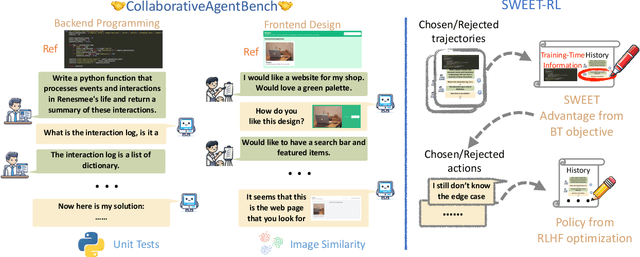

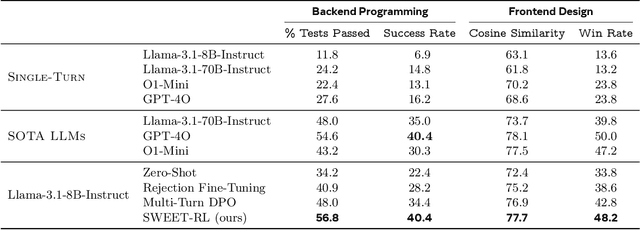

Abstract:Large language model (LLM) agents need to perform multi-turn interactions in real-world tasks. However, existing multi-turn RL algorithms for optimizing LLM agents fail to perform effective credit assignment over multiple turns while leveraging the generalization capabilities of LLMs and it remains unclear how to develop such algorithms. To study this, we first introduce a new benchmark, ColBench, where an LLM agent interacts with a human collaborator over multiple turns to solve realistic tasks in backend programming and frontend design. Building on this benchmark, we propose a novel RL algorithm, SWEET-RL (RL with Step-WisE Evaluation from Training-time information), that uses a carefully designed optimization objective to train a critic model with access to additional training-time information. The critic provides step-level rewards for improving the policy model. Our experiments demonstrate that SWEET-RL achieves a 6% absolute improvement in success and win rates on ColBench compared to other state-of-the-art multi-turn RL algorithms, enabling Llama-3.1-8B to match or exceed the performance of GPT4-o in realistic collaborative content creation.
NaturalReasoning: Reasoning in the Wild with 2.8M Challenging Questions
Feb 18, 2025Abstract:Scaling reasoning capabilities beyond traditional domains such as math and coding is hindered by the lack of diverse and high-quality questions. To overcome this limitation, we introduce a scalable approach for generating diverse and challenging reasoning questions, accompanied by reference answers. We present NaturalReasoning, a comprehensive dataset comprising 2.8 million questions that span multiple domains, including STEM fields (e.g., Physics, Computer Science), Economics, Social Sciences, and more. We demonstrate the utility of the questions in NaturalReasoning through knowledge distillation experiments which show that NaturalReasoning can effectively elicit and transfer reasoning capabilities from a strong teacher model. Furthermore, we demonstrate that NaturalReasoning is also effective for unsupervised self-training using external reward models or self-rewarding.
LLM Pretraining with Continuous Concepts
Feb 12, 2025Abstract:Next token prediction has been the standard training objective used in large language model pretraining. Representations are learned as a result of optimizing for token-level perplexity. We propose Continuous Concept Mixing (CoCoMix), a novel pretraining framework that combines discrete next token prediction with continuous concepts. Specifically, CoCoMix predicts continuous concepts learned from a pretrained sparse autoencoder and mixes them into the model's hidden state by interleaving with token hidden representations. Through experiments on multiple benchmarks, including language modeling and downstream reasoning tasks, we show that CoCoMix is more sample efficient and consistently outperforms standard next token prediction, knowledge distillation and inserting pause tokens. We find that combining both concept learning and interleaving in an end-to-end framework is critical to performance gains. Furthermore, CoCoMix enhances interpretability and steerability by allowing direct inspection and modification of the predicted concept, offering a transparent way to guide the model's internal reasoning process.
Spectral Journey: How Transformers Predict the Shortest Path
Feb 12, 2025Abstract:Decoder-only transformers lead to a step-change in capability of large language models. However, opinions are mixed as to whether they are really planning or reasoning. A path to making progress in this direction is to study the model's behavior in a setting with carefully controlled data. Then interpret the learned representations and reverse-engineer the computation performed internally. We study decoder-only transformer language models trained from scratch to predict shortest paths on simple, connected and undirected graphs. In this setting, the representations and the dynamics learned by the model are interpretable. We present three major results: (1) Two-layer decoder-only language models can learn to predict shortest paths on simple, connected graphs containing up to 10 nodes. (2) Models learn a graph embedding that is correlated with the spectral decomposition of the line graph. (3) Following the insights, we discover a novel approximate path-finding algorithm Spectral Line Navigator (SLN) that finds shortest path by greedily selecting nodes in the space of spectral embedding of the line graph.
SHARP: Accelerating Language Model Inference by SHaring Adjacent layers with Recovery Parameters
Feb 11, 2025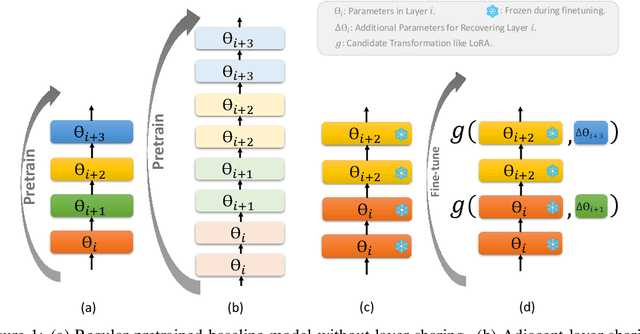

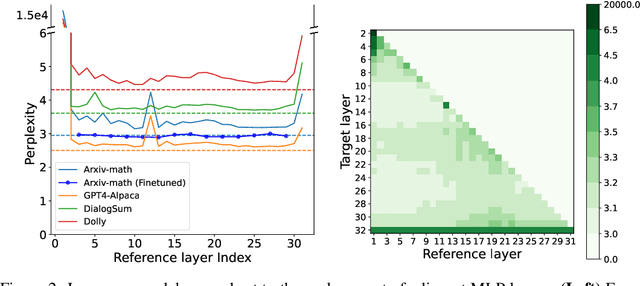
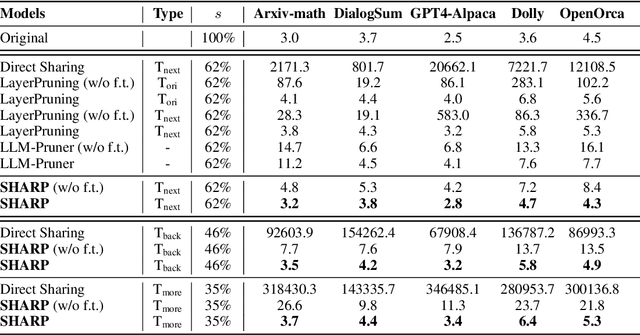
Abstract:While Large language models (LLMs) have advanced natural language processing tasks, their growing computational and memory demands make deployment on resource-constrained devices like mobile phones increasingly challenging. In this paper, we propose SHARP (SHaring Adjacent Layers with Recovery Parameters), a novel approach to accelerate LLM inference by sharing parameters across adjacent layers, thus reducing memory load overhead, while introducing low-rank recovery parameters to maintain performance. Inspired by observations that consecutive layers have similar outputs, SHARP employs a two-stage recovery process: Single Layer Warmup (SLW), and Supervised Fine-Tuning (SFT). The SLW stage aligns the outputs of the shared layers using L_2 loss, providing a good initialization for the following SFT stage to further restore the model performance. Extensive experiments demonstrate that SHARP can recover the model's perplexity on various in-distribution tasks using no more than 50k fine-tuning data while reducing the number of stored MLP parameters by 38% to 65%. We also conduct several ablation studies of SHARP and show that replacing layers towards the later parts of the model yields better performance retention, and that different recovery parameterizations perform similarly when parameter counts are matched. Furthermore, SHARP saves 42.8% in model storage and reduces the total inference time by 42.2% compared to the original Llama2-7b model on mobile devices. Our results highlight SHARP as an efficient solution for reducing inference costs in deploying LLMs without the need for pretraining-scale resources.
 Add to Chrome
Add to Chrome Add to Firefox
Add to Firefox Add to Edge
Add to Edge